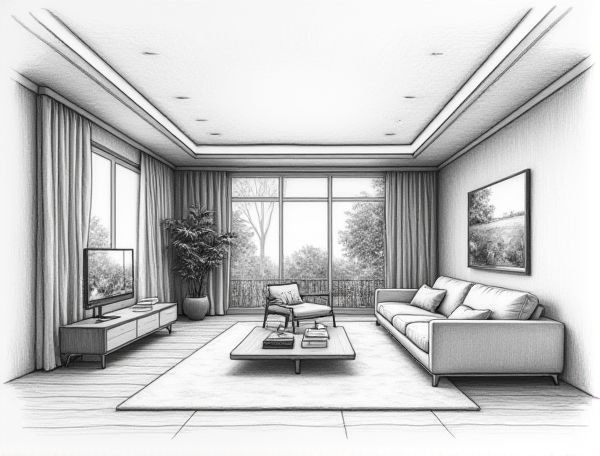
Photo illustration: Smart home design with circadian rhythm lighting
Integrating circadian rhythm lighting into your smart home design enhances natural sleep patterns and overall well-being by adjusting light intensity and color throughout the day. Discover how this innovative technology can transform your living space for better health and comfort in the full article.
Introduction to Circadian Rhythm Lighting in Smart Homes
Circadian rhythm lighting in smart homes mimics natural daylight patterns to enhance your well-being by regulating sleep, mood, and productivity. These lighting systems adjust color temperature and intensity throughout the day, promoting healthier sleep cycles and reducing eye strain. Implementing circadian lighting can transform your living space into a supportive environment that aligns with your body's internal clock.
Understanding Circadian Rhythms and Their Importance
Understanding circadian rhythms is crucial for designing homes that promote well-being and health by aligning living spaces with natural light cycles. Your architecture and interior design choices can optimize exposure to natural daylight and minimize artificial light disruptions, supporting better sleep patterns and overall mood. Incorporating features like adjustable lighting, window placements, and smart shading systems helps synchronize daily activities with your body's internal clock.
Benefits of Circadian Lighting for Health and Wellbeing
Circadian lighting supports your natural sleep-wake cycle by mimicking natural daylight patterns, which enhances mood, boosts energy levels, and improves overall mental clarity. Integrating this lighting into your home design promotes better sleep quality, reduces stress, and fosters a healthier living environment tailored to your biological rhythms.
Key Components of a Circadian Smart Lighting System
Circadian smart lighting systems integrate tunable LED bulbs that mimic natural daylight patterns by adjusting color temperature and intensity throughout the day. These systems utilize sensors to monitor ambient light and occupant activity, enabling automated adjustments that support the human circadian rhythm. Advanced control units with programmable schedules and mobile app connectivity enhance personalized lighting experiences, promoting improved sleep quality and overall well-being.
Integrating Smart Lighting with Home Automation
Smart lighting integration with home automation enhances energy efficiency and user convenience by enabling customizable lighting scenes controlled via voice assistants or smartphone apps. Utilizing IoT-enabled LED bulbs and sensors, homeowners can automate lighting schedules, adjust brightness, and optimize ambiance to suit daily routines and moods.
Designing Lighting Schedules for Daily Rhythms
Designing lighting schedules tailored to your home's daily rhythms enhances comfort and supports natural circadian patterns by adjusting brightness and color temperature throughout the day. Integrating smart lighting systems allows you to automate these changes, promoting energy efficiency while aligning with your household's unique activities and preferences.
Choosing the Right Smart Bulbs and Fixtures
Selecting the right smart bulbs and fixtures involves considering factors such as brightness, color temperature, energy efficiency, and compatibility with home automation systems like Alexa or Google Home. Energy-efficient LED smart bulbs with adjustable color settings enhance ambiance and reduce electricity consumption, while fixtures designed for smart technology ensure seamless integration and aesthetic appeal. Prioritize bulbs with high lumens output and durable construction to optimize both functionality and style in a smart home environment.
User-Friendly Controls and Customization Options
User-friendly controls in home design software streamline the creative process, allowing you to easily adjust layouts, colors, and materials with intuitive interfaces. Customization options enable personalized solutions tailored to your unique style and functional needs, enhancing your overall design experience.
Energy Efficiency and Sustainability in Smart Home Lighting
Smart home lighting integrates energy-efficient LED technology with automated sensors and smart controls to reduce electricity consumption while enhancing comfort and convenience. Incorporating solar-powered lighting systems and recyclable materials further promotes sustainability by minimizing carbon footprint and conserving natural resources.
Future Trends in Circadian Lighting and Smart Homes
Future trends in circadian lighting emphasize dynamic, tunable light systems that mimic natural daylight patterns to enhance mood, productivity, and sleep quality in smart homes. Integrating these advanced lighting solutions with AI-driven smart home technologies enables personalized, automated adjustments based on your daily routines and environmental changes. This synergy of circadian lighting and smart home innovation revolutionizes wellness-centered living spaces by optimizing both comfort and health.
 homedesy.com
homedesy.com